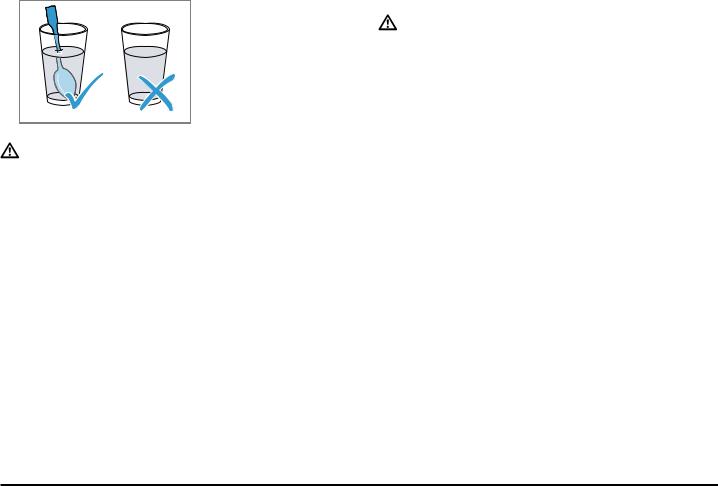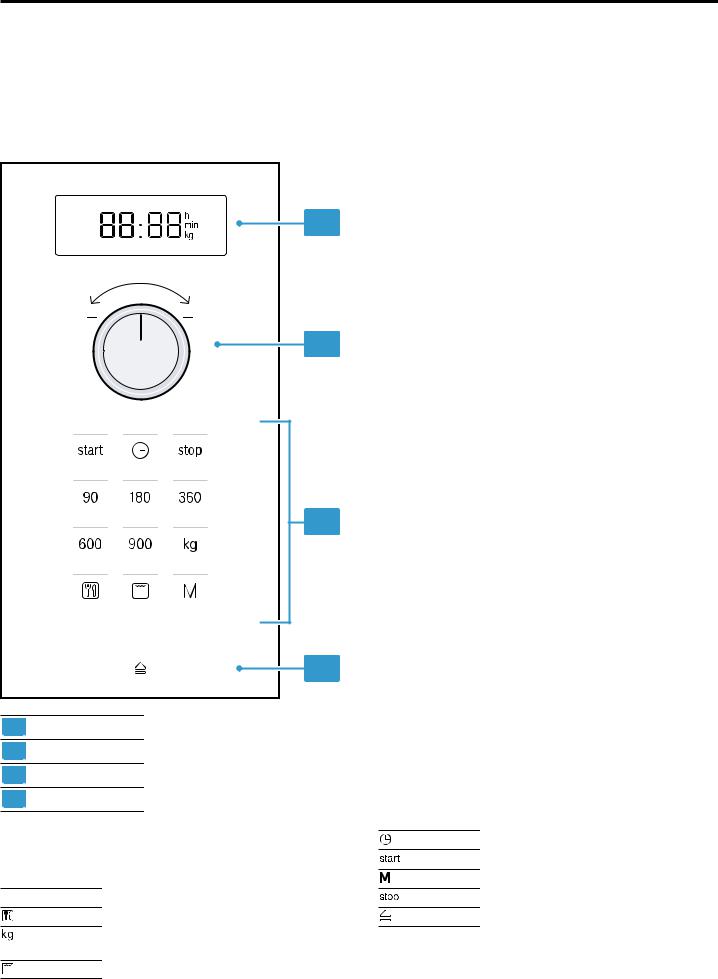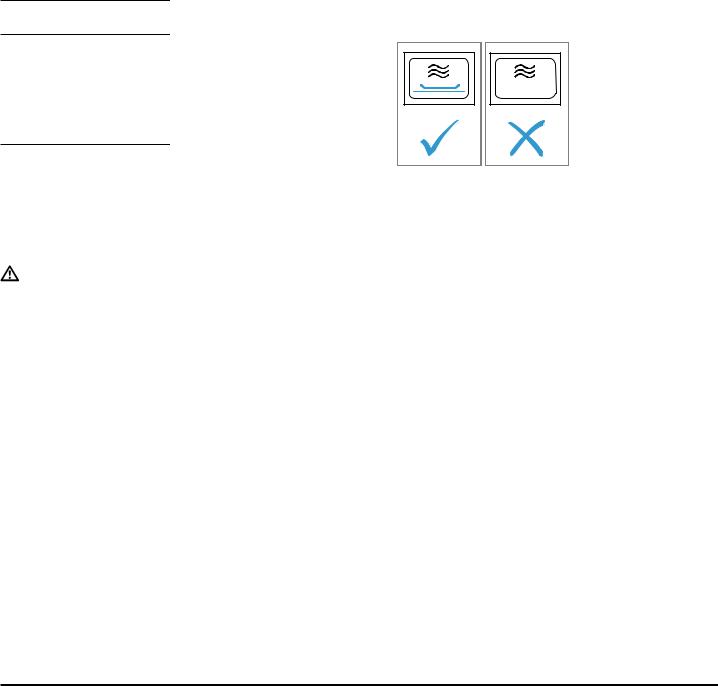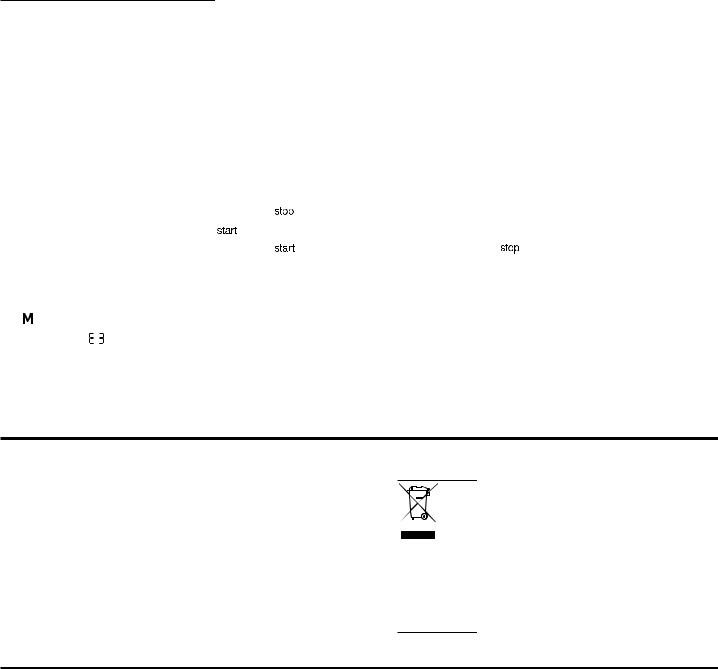Bosch BEL554MS0 User manual and assembly instructions

Register |
your |
||
new |
|
||
|
|
||
device |
|||
MyBosch |
|
on |
|
now |
|||
|
|||
getfree |
|
and |
|
benefits: |
|||
bosch |
|
|
|
-home |
|
||
|
.com/ |
||
welcome |
|||
Microwave Oven
BEL554MS0
[en] |
User manual and installation instructions |
2 |
[id] |
Panduan pengoperasian dan petunjuk pemasangan |
26 |

en Safety |
|
|
Table of contents |
|
|
USER MANUAL |
|
|
1 |
Safety.................................................................... |
2 |
2 |
Preventing material damage ............................... |
5 |
3 |
Environmental protection and saving en- |
|
|
ergy ....................................................................... |
6 |
4 |
Familiarising yourself with your appliance ........ |
7 |
5 |
Accessories.......................................................... |
8 |
6 |
Before using for the first time ............................. |
8 |
7 |
Basic operation .................................................... |
9 |
8 |
Grill ..................................................................... |
10 |
9 |
Memory ............................................................... |
11 |
10 |
Programmes ....................................................... |
11 |
11 |
Basic settings..................................................... |
13 |
12 |
Cleaning and servicing...................................... |
13 |
13 |
Troubleshooting................................................. |
15 |
14 |
Disposal.............................................................. |
16 |
15 |
Customer Service............................................... |
16 |
16 |
How it works....................................................... |
17 |
17 |
INSTALLATION INSTRUCTIONS ....................... |
23 |
17.1 |
Safe installation ................................................. |
23 |


 1 Safety
1 Safety
Observe the following safety instructions.
1.1 General information
¡Read this instruction manual carefully.
¡Keep the instruction manual and the product information safe for future reference or for the next owner.
¡Do not connect the appliance if it has been damaged in transit.
1.2 Intended use
Only a licensed professional may connect appliances without plugs. Damage caused by incorrect connection is not covered under the warranty.
The appliance can only be used safely if it is correctly installed according to the safety instructions. The installer is responsible for ensuring that the appliance works perfectly at its installation location.
Only use this appliance:
¡To prepare meals and drinks.
¡Under supervision. Never leave the appliance unattended when cooking for short periods.
¡In private households and in enclosed spaces in a domestic environment.
¡Up to an altitude of max. 4000 m above sea level.
This appliance complies with the standards EN 55011 and CISPR 11. It is a group 2, class B product. Group 2 means that microwaves are produced for the purpose of heating food. Class B means that the appliance is suitable for private households.
1.3 Restriction on user group
This appliance may be used by children aged 8 or over and by people who have reduced physical, sensory or mental abilities or inadequate experience and/or knowledge, provided that they are supervised or have been instructed on how to use the appliance safely and have understood the resulting dangers.
Children must not play with the appliance. Children must not perform cleaning or user maintenance unless they are at least 15 years old and are being supervised.
Keep children under the age of 8 years away from the appliance and power cable.
1.4 Safe use
WARNING ‒ Risk of fire!
Combustible objects that are left in the cooking compartment may catch fire.
Never store combustible objects in the cooking compartment.
If smoke is emitted, the appliance must be switched off or the plug must be pulled out and the door must be held closed in order to stifle any flames.
2

Loose food remnants, fat and meat juices may catch fire.
Before using the appliance, remove the worst of the food residues and remnants from the cooking compartment, heating elements and accessories.
Overheating can cause a fire.
Never install the appliance behind a decorative door or the door of a kitchen unit.
WARNING ‒ Risk of burns!
The appliance and its parts that can be touched become hot during use.
Caution should be exercised here in order to avoid touching heating elements.
Young children under 8 years of age must be kept away from the appliance.
Accessories and cookware get very hot.
Always use oven gloves to remove accessories or cookware from the cooking compartment.
When the cooking compartment is hot, any alcoholic vapours inside may catch fire.
Only use small quantities of drinks with a high alcohol content in food.
Open the appliance door carefully.
WARNING ‒ Risk of scalding!
The accessible parts of the appliance become hot during operation.
Never touch these hot parts.
Keep children at a safe distance.
Hot steam may escape when you open the appliance door. Steam may not be visible, depending on the temperature.
Open the appliance door carefully.
Keep children at a safe distance.
If there is water in the cooking compartment when it is hot, this may create hot steam.
Never pour water into the cooking compartment when the cooking compartment is hot.
WARNING ‒ Risk of injury!
Scratched glass in the appliance door may develop into a crack.
Do not use any harsh or abrasive cleaners or sharp metal scrapers to clean the glass on the appliance door, as they may scratch the surface.
Safety en
The hinges on the appliance door move when the door is opened and closed, which could trap your fingers.
Keep your hands away from the hinges. Cracks, splinters or breaks in the glass turntable are dangerous.
Never allow hard objects to strike the turntable.
Handle the turntable with care.
WARNING ‒ Risk of electric shock!
Incorrect repairs are dangerous.
Repairs to the appliance should only be carried out by trained specialist staff.
Only use genuine spare parts when repairing the appliance.
If the power cord of this appliance is damaged, it must be replaced by the manufacturer, the manufacturer's Customer Service or a similarly qualified person in order to prevent any risk.
If the insulation of the power cord is damaged, this is dangerous.
Never let the power cord come into contact with hot appliance parts or heat sources.
Never let the power cord come into contact with sharp points or edges.
Never kink, crush or modify the power cord.
An ingress of moisture can cause an electric shock.
Do not use steamor high-pressure cleaners to clean the appliance.
If the appliance or the power cord is damaged, this is dangerous.
Never operate a damaged appliance.
Never operate an appliance with a cracked or fractured surface.
Call customer services. → Page 16
WARNING ‒ Risk of suffocation!
Children may put packaging material over their heads or wrap themselves up in it and suffocate.
Keep packaging material away from children.
Do not let children play with packaging material.
Children may breathe in or swallow small parts, causing them to suffocate.
Keep small parts away from children.
Do not let children play with small parts.
3

en Safety
1.5 Microwave
Follow these safety instructions when using the microwave.
WARNING ‒ Risk of fire!
Using the appliance for anything other than its intended purpose is dangerous and may cause damage. For example, heated slippers and pillows filled with grain or cereal may catch fire, even several hours later.
Never dry food or clothing with the appliance.
Never heat up slippers, pillows filled with grain or cereal, sponges, damp cleaning cloths or similar with the appliance.
The appliance must only be used to prepare food and drink.
Food may catch fire.
Never heat food contained in heat-retaining packaging.
Do not leave food heating unattended in containers made of plastic, paper or other combustible materials.
Never set the microwave power too high or the cooking time too long. Follow the instructions provided in this instruction manual.
Never use the microwave to dry food.
Never defrost or heat food with a low water content, such as bread, at too high a microwave power or for too long.
Cooking oil may catch fire.
Never use the microwave to heat cooking oil on its own.
WARNING ‒ Risk of explosion!
Liquids and other food may explode when in containers that have been tightly sealed.
Never heat liquids or other food in containers that have been tightly sealed.
WARNING ‒ Risk of burns!
Foods with peel or skin may burst or explode during heating, or even afterwards.
Never cook eggs in their shells or reheat hard-boiled eggs.
Never cook shellfish or crustaceans.
Always prick the yoke when baking or poaching eggs.
The skin of foods that have a peel or skin, such as apples, tomatoes, potatoes and sausages, may burst. Always prick the peel or skin before heating.
Heat is not distributed evenly through baby food.
Never heat baby food in closed containers.
Always remove the lid or teat.
Stir or shake well after heating.
Check the temperature before giving the food or drink to a child.
Heated food gives off heat. The cookware may become hot.
Always use oven gloves to remove cookware or accessories from the cooking compartment.
Airtight packaging may burst when food is heated.
Always follow the instructions on the packaging.
Always use oven gloves to remove dishes from the cooking compartment.
The accessible parts of the appliance become hot during operation.
Never touch these hot parts.
Keep children at a safe distance.
Using the appliance for anything other than its intended purpose is dangerous. This is because, for instance, overheated slippers, pillows filled with grain or cereal, sponges and damp cleaning cloths, etc., may cause burns to the skin.
Never dry food or clothing with the appliance.
Never heat up slippers, pillows filled with grain or cereal, sponges, damp cleaning cloths or similar with the appliance.
The appliance must only be used to prepare food and drink.
WARNING ‒ Risk of scalding!
There is a possibility of delayed boiling when a liquid is heated. This means that the liquid reaches boiling temperature without the usual steam bubbles rising to the surface. Even if the container only vibrates a little, the hot liquid may suddenly boil over and spatter.
4

Always place a spoon in the container when heating liquids. This will prevent delayed boiling.
WARNING ‒ Risk of injury!
Unsuitable cookware may crack. Porcelain or ceramic cookware can have small perforations in the handles and lid. These perforations conceal a cavity below. If moisture penetrates this cavity, it could cause the cookware to crack.
Only use microwave-safe cookware. Cookware and containers made from metal or cookware with metal edging may lead to sparks being formed during simple microwave operation. The appliance is damaged.
Never use metal containers during mi- crowave-only operation.
Preventing material damage en
Only use microwave-safe cookware or use the microwave in combination with a type of heating.
WARNING ‒ Risk of electric shock!
The appliance uses a high voltage.Never remove the casing.
 WARNING ‒ Risk of serious harm to health!
WARNING ‒ Risk of serious harm to health!
The surface of the appliance may become damaged if it is not cleaned properly. Microwave energy may escape.
Clean the appliance on a regular basis, and remove any food residue immediately.
Always keep the cooking compartment, door and door stop clean.
Microwave energy may escape if the cooking compartment door is damaged.
Never use the appliance if the cooking compartment door or the plastic door frame is damaged.
Call the customer service.
Microwave energy will escape from appliances that do not have any casing.
Never remove the casing.
Contact our after-sales service if maintenance or repair work is needed.
2 Preventing material damage
2.1 General
ATTENTION!
When the cooking compartment is hot, any water inside it will create steam. The change in temperature may cause damage.
Never pour water into the cooking compartment when it is still hot.
The prolonged presence of moisture in the cooking compartment leads to corrosion.
Always wipe away the condensation after cooking.
Do not keep moist food in the cooking compartment for a long time with the door closed.
Do not store food in the cooking compartment.
Leaving the appliance to cool down with the door open will damage the front of neighbouring kitchen units over time.
Always allow the cooking compartment to cool down with the door closed after cooking at high temperatures.
Take care not to trap anything in the appliance door.
Only leave the cooking compartment to dry with the door open if a lot of moisture was produced during operation.
Sitting or placing objects on the appliance door may damage it.
Do not place or hang objects on the appliance door.
2.2 Microwave
Follow these instructions when using the microwave.
ATTENTION!
Metal touching the wall of the cooking compartment will cause sparks, which may damage the appliance or the inner door pane.
Metal (e.g. a spoon in a glass) must be kept at least 2 cm from the cooking compartment walls and the inside of the door.
Placing aluminium containers in the appliance may cause sparks, which will damage the appliance.
Do not use aluminium containers in the appliance. Operating the appliance without food in the cooking compartment may lead to overloading.
5

en Environmental protection and saving energy
Do not switch on the microwave unless there is food inside. The only exception to this rule is when performing a short cookware test.
If you prepare several bags of microwave popcorn in immediate succession at a microwave power level that is too high, the cooking compartment may be damaged.
Leave the appliance to cool down for several minutes between each use.
Never set a microwave power level that is too high.
Use a maximum microwave output of 600 watts.
Always place the popcorn bag on a glass plate. The microwave feed is damaged by the removal of the cover.
Never remove the cover of the microwave feed in the cooking compartment.
Removing the transparent film from the inside of the door damages the appliance door.
Never remove the transparent film on the inside of the door.
Liquid that penetrates the interior of the appliance may damage the turntable drive.
Monitor the cooking process.
Set a shorter cooking time first and, if necessary, increase the cooking time.
Never use the appliance without the turntable.
Using unsuitable cookware may result in damage.
When using the grill, the microwave combi mode or the hot air, only use tableware that can withstand the high temperatures.
3 Environmental protection and saving energy
3.1 Disposing of packaging
The packaging materials are environmentally compatible and can be recycled.
Sort the individual components by type and dispose of them separately.
3.2 Saving energy
If you follow these instructions, your appliance will use less power.
Open the appliance door as little as possible during operation.
¡This will maintain the temperature in the cooking compartment and eliminate the need for the appliance to reheat.
Hide the clock in standby mode.
¡ The appliance saves energy in standby mode.
6

Familiarising yourself with your appliance en
4 Familiarising yourself with your appliance
4.1 Control panel
You can use the control panel to configure all functions of your appliance and to obtain information about the operating status.
Note: On certain models, specific details such as colour and shape may differ from those pictured.
4
3 |
2 |
1 |
 1
1 
 2
2 
 3
3 
 4
4 
Automatic door opener |
Open the door automatically. |
Touch fields |
Select functions. |
Rotary selector |
Set the time, cooking time or automatic programmes. |
Display |
Display clock or cooking time. |
Touch fields
Touch fields are touch-sensitive surfaces. To select a function, touch the relevant field.
90–900 Select the microwave power in watts.
Select the automatic programmes.
Select the weight for the programmes.
Select the grill.
Set or display the time.
Start the operation.
Select "Memory".
Stop or pause the operation.
Open the appliance door.
7

en Accessories
Rotary selector
Use the rotary selector to change the setting values that are shown on the display.
The rotary selector can be pushed in. To engage or release the rotary selector, push the rotary selector.
Automatic door opener
When you press the automatic door opener, the appliance door springs open. You can fully open the appliance door manually.
Notes
¡In the event of a power cut, the automatic door opener does not work. You can open the door manually.
¡If you open the appliance door during operation, this pauses the operation.
¡When you close the appliance door, the operation does not continue automatically. You must restart the operation.
¡If the appliance is switched off for an extended period of time, the appliance door opens with a time delay.
4.2 Types of heating
Here you can find an overview of the types of heating. You can find recommendations on using the types of heating.
Symbol |
Name |
Use |
90–900 |
Microwave |
Defrosting, cooking or heating food and liquids. |
|
Grill |
¡ Grill flat items, such as steak, sausages or toast. |
|
|
¡ Gratinate food. |
|
Microwave combined |
¡ Bake bakes and gratins. |
|
operation |
¡ Brown dishes. |
4.3 Cooling fan
The cooling fan switches on and off as required. The cooking compartment remains cold during mi-
crowave operation. Despite this, the cooling fan will still switch on.
Note: The cooling fan may run on even if the oven has been switched off.
4.4 Condensation
Condensation can occur in the cooking compartment and on the appliance door when cooking. Condensation is normal and does not adversely affect appliance operation. Wipe away the condensation after cooking.
5 Accessories
Use original accessories. These have been made especially for your appliance.
Accessories |
Use |
Wire rack |
¡ Wire rack for grilling |
|
and browning |
|
¡ Use the wire rack and |
|
place the cookware on |
|
it |
6 Before using for the first time
Configure the settings for initial start-up. Clean the appliance and accessories.
6.1 Initial configuration
Configure the settings for initial start-up. Clean the appliance and accessories.
Note: After connecting the appliance to the power or following a power cut, a signal sounds and several zeros are shown on the display. It may take a few seconds until a signal sounds and you can set the time.
1. Press  .
.
a12:00 is shown on the display. The indicator light lights up via  .
.
2.Set the clock using the rotary selector.
3.Press  .
.
6.2 Heating up the cooking compartment
1. Press  .
.
aThe indicator lamp above  lights up and the display shows 10:00 min.
lights up and the display shows 10:00 min.
2. Press 

 .
.
8

3.Once the cooking compartment has cooled down, clean the smooth surfaces with soapy water and a dish cloth.
6.3 Cleaning the accessories
Clean the accessory thoroughly with soapy water and a soft dish cloth.
Basic operation en
6.4 Fitting the turntable
Never use the appliance without the turntable.
1.Place the roller ring  into the recess in the cooking compartment.
into the recess in the cooking compartment.
2.Engage the turntable  in the drive
in the drive  in the centre of the cooking compartment floor.
in the centre of the cooking compartment floor.
3.Check whether the turntable is correctly engaged.
Note: The turntable can turn anti-clockwise or clockwise.
7 Basic operation
7.1 Microwave power settings
This is where you can find an overview of the different microwave power settings and when to use them.
Microwave power |
Use |
setting in watts |
|
90 |
Defrost delicate foods. |
180 |
Defrost food and continue |
|
cooking. |
360 |
Cooking meat and fish or heat- |
|
ing delicate foods. |
600 |
Heat and cook food. |
900 |
Heat liquids. |
Note:
You can set the microwave power settings for a particular cooking time:
¡900 W for 30 minutes
¡600 W for 60 minutes
¡90 W, 360 W, 180 W for 99 minutes
7.2 Microwave-safe cookware and accessories
To heat food evenly and avoid damaging your appliance, it is important to use the right cookware and accessories.
Note: Read the manufacturer's instructions before using any cookware in the microwave. If in doubt, carry out a cookware test.
Microwave-safe
Cookware and accessor- |
Reason |
|
ies |
|
|
Cookware made from |
These materials allow mi- |
|
heat-resistant, microwave- |
crowaves to pass |
|
safe material: |
through. Microwaves do |
|
¡ |
Glass |
not damage heat-resistant |
¡ |
Glass ceramic |
cookware. |
¡Porcelain
¡Temperature-resistant plastic
¡Fully glazed ceramic without cracks
Metal cutlery |
Note: You can use metal |
|
cutlery, e.g. place a |
|
spoon in a glass, to pre- |
|
vent delayed boiling. |
ATTENTION!
Metal touching the wall of the cooking compartment will cause sparks, which may damage the appliance or the inner door pane.
Metal (e.g. a spoon in a glass) must be kept at least 2 cm from the cooking compartment walls and the inside of the door.
Not microwave-safe
Cookware and accessor- |
Reason |
ies |
|
Metal cookware |
Metal does not allow mi- |
|
crowaves to pass |
|
through. The food hardly |
|
heats up. |
9

en Grill
Cookware and accessorReason ies
Cookware with gold or silMicrowaves can damage ver decoration gold and silver decora-
tion.
Tip: You can only use this kind of cookware if the manufacturer guarantees that it is microwave-safe.
7.3 Testing cookware for microwave suitability
Test cookware to see whether it is suitable for microwave use. Testing cookware is the only time the appliance should be operated in microwave mode without any food inside.
WARNING ‒ Risk of scalding!
The accessible parts of the appliance become hot during operation.
Never touch these hot parts.
Keep children at a safe distance.
1.Place the empty cookware in the cooking compartment.
2.Set the appliance to the maximum microwave power setting for 30 seconds to 1 minute.
3.Start the operation.
4.Check the cookware several times:
–If the cookware is cold or warm to the touch, it is suitable for microwave use.
–If the cookware becomes hot or sparks are created, stop the cookware test. The cookware is not microwave-safe.
7.4 Configuring the microwave settings
ATTENTION!
Operating the appliance without food in the cooking compartment may lead to overloading.
Do not switch on the microwave unless there is food inside. The only exception to this rule is when performing a short cookware test.
Tip: To ensure optimum use of your appliance, you can refer to the information in the recommended settings.
→ "How it works", Page 17
1.Follow the safety instructions. → Page 4
2.Read the safety instructions and the section on how to prevent material damage. → Page 5
3.Read the information on microwave-safe cookware and accessories. → Page 9
4.Use the buttons to set the required microwave power setting.
5.Use the rotary selector to set the required duration.
Note: If you open the cooking compartment door during operation, the microwave interrupts the operation and pauses the set time that is counting down. When you close the cooking compartment door, the operation continues.
7.5 Changing the cooking time
You can change the cooking time at any time.
Use the rotary selector to set the required duration.
7.6 Pausing operation
1. Press 
 or open the appliance door. a The indicator light lights up via
or open the appliance door. a The indicator light lights up via 

 .
.
2.To continue the operation, close the appliance door and press 

 .
.
7.7 Cancelling the operation
Press 
 twice or open the door and press
twice or open the door and press 
 once.
once.
8 Grill
You can brown or gratinate your food using the grill. You can use the grill on its own or in combination with the microwave.
8.1 Setting the grill
1. Press  .
.
aThe indicator lamp above  lights up and the display shows 10:00 min.
lights up and the display shows 10:00 min.
2. Use the rotary selector to set the required duration.
8.3 Pausing operation
1. Press 
 or open the appliance door. a The indicator light lights up via
or open the appliance door. a The indicator light lights up via 

 .
.
2.To continue the operation, close the appliance door and press 

 .
.
8.4 Cancelling the operation
Press 
 twice or open the door and press
twice or open the door and press 
 once.
once.
8.2 Changing the cooking time
You can change the cooking time at any time.
Use the rotary selector to set the required duration.
10

8.5 MicroCombi
To reduce the cooking time, you can use the grill in combination with microwave mode.
Setting MicroCombi
1. Press the microwave power setting 90, 180 or 360.
aThe indicator lamp above the pressed button lights up and the display shows 1:00 min.
Memory en
2.Press  .
.
3.Use the rotary selector to set the required duration.
Note: If you open the cooking compartment door during operation, the microwave interrupts the operation and pauses the set time that is counting down. When you close the cooking compartment door, the operation continues.
9 Memory
You can use the memory function to save the setting for a dish and call it up again at any time.
Tip: If you prepare one dish often, use the memory function.
9.1 Saving memory settings
Note:
¡You cannot save several microwave power settings in succession.
¡You cannot save any automatic programmes.
1. Press  .
.
a The indicator light lights up via  .
.
2.Use the buttons to set the required microwave power setting.
aThe indicator lamp above the button lights up and the display shows 1:00 min.
3.Use the rotary selector to set the required duration.
4.If required, select one of the options:
‒To save the memory and immediately start, press


 .
.
‒ To save the memory and not start, press  .
.
aIf the appliance does not start, the time appears on the display and the appliance saves the setting.
9.2 Starting the memory
It is very easy to start the saved programme. Place your dish in the appliance and close the appliance door.
1. Press  .
.
a The saved settings are displayed. 2. Press 

 .
.
9.3 Pausing operation
1. Press 
 or open the appliance door. a The indicator light lights up via
or open the appliance door. a The indicator light lights up via 

 .
.
2.To continue the operation, close the appliance door and press 

 .
.
9.4 Cancelling the operation
Press 
 twice or open the door and press
twice or open the door and press 
 once.
once.
10 Programmes
The programmes help you to use your appliance to prepare different dishes by selecting the optimum settings automatically.
10.1 Setting a programme
1.Select a programme.
2.Press  repeatedly until the display shows the required programme number.
repeatedly until the display shows the required programme number.
a The indicator light lights up via  . 3. Press
. 3. Press  .
.
aThe indicator lamp above  lights up and the display shows a suggested value for the weight.
lights up and the display shows a suggested value for the weight.
4.Turn the rotary selector to specify the weight of the dish.
If it is not possible to enter the exact weight, round the weight up or down.
5. Press 

 to start the operation.
to start the operation.
a The cooking time visibly counts down.
6.If an audible signal sounds during the programme, open the appliance door.
‒Break up, stir or turn the food.
‒Close the appliance door.
‒Press 

 .
.
10.2 Pausing operation
1. Press 
 or open the appliance door. a The indicator light lights up via
or open the appliance door. a The indicator light lights up via 

 .
.
2.To continue the operation, close the appliance door and press 

 .
.
10.3 Cancelling the operation
Press 
 twice or open the door and press
twice or open the door and press 
 once.
once.
11

en Programmes
10.4 Defrosting with the automatic programmes
You can use the four defrosting programmes to defrost meat, poultry and bread.
Programme |
Food |
Cookware |
Weight range in kg |
P01 |
Minced meat |
Open |
0.20–1.00 |
P02 |
Pieces of meat |
Open |
0.20–1.00 |
P03 |
Chicken, chicken pieces |
Open |
0.40–1.80 |
P04 |
Bread |
Open |
0.20–1.00 |
Defrosting food using the automatic programmes
1.Take the food out of its packaging.
Use food that is stored flat and in portion-sized quantities at -18 °C.
2.Weigh the food.
You require the weight in order to set the programme.
3.Place the food in a microwaveable shallow dish, e.g. a glass plate or porcelain plate.
Do not put the cover on.
4.Set the programme. → Page 11
5.Note: Liquid is produced when you defrost meat and poultry.
Drain off any liquid when turning and under no circumstances use it for other purposes or allow it to come into contact with other foods.
6.Flat pieces of meat and items made from minced meat should be separated from each other before leaving to stand.
7.The defrosted food should be left to stand for an additional 10 to 30 minutes until it reaches an even temperature.
Large pieces of meat require a longer standing time than smaller pieces. For poultry, remove the giblets after the resting time.
8.Continue to prepare the food, even though thick pieces of meat may still be frozen in the middle.
10.5 Cooking with the automatic programmes
With the three cooking programmes, you can cook rice, potatoes or vegetables.
Programme |
Food |
Cookware |
Weight range |
Information |
|
|
|
in kg |
|
P05 |
Rice |
With lid |
0.05–0.20 |
¡ For rice, use a large, deep dish. |
|
|
|
|
¡ Do not use any boil-in-the-bag rice. |
|
|
|
|
¡ For every 100 g rice, add twice to three times the |
|
|
|
|
amount of water. |
P06 |
Potatoes |
With lid |
0.15–1.00 |
¡ For boiled potatoes, cut fresh potatoes into small, |
|
|
|
|
equally sized pieces. |
|
|
|
|
¡ Add one tablespoon of water and a little salt for every |
|
|
|
|
100 g boiled potatoes. |
P07 |
Vegetables |
With lid |
0.15–1.00 |
¡ Weigh fresh, washed vegetables scales. |
|
|
|
|
¡ Cut the vegetables into small, uniform pieces. |
|
|
|
|
¡ Add one tablespoon of water for every 100 g boiled |
|
|
|
|
potatoes. |
Cooking food with the automatic programmes
1.Weigh the food.
You require the weight in order to set the programme.
2.Place the food on microwave-safe cookware and cover with a lid.
3.Add the volume of water in accordance with the manufacturer's instructions on the packaging.
4.Set the programme. → Page 11
5.Once the programme has finished, stir the food again.
6.The food should be left to stand for an additional 5 to 10 minutes until it reaches a uniform temperature.
The cooking results are dependent on the food quality and consistency of the food.
10.6 Combi-cooking programme
With the combi cooking programme, you combine microwave and grill.
Programme |
Food |
Cookware |
Weight range in kg |
P08 |
Frozen bake, up to 3 cm deep |
Open |
0.40–0.90 |
12

Cooking food using the combi cooking programme
1.Take the food out of its packaging.
2.Weigh the food.
You require the weight in order to set the programme.
Basic settings en
3.Place the food in microwave-safe, heat-resistant cookware that is not too big.
4.Set the programme. → Page 11
5.Once the programme has finished, leave the food to rest for another 5–10 minutes to allow the temperature to even out.
11 Basic settings
You can configure the appliance to meet your needs.
11.1 Overview of the basic settings
Here you can find an overview of the basic settings and factory settings. The basic settings depend on the features of your appliance.
Setting |
Selection |
Meaning |
|
Button tone |
1 |
Switch on the button tone. |
|
|
|
||
Button tone |
|
Switch off the button tone. |
|
|
|
Note: The button tone remains active for |
and . |
Demo mode |
|
Activate or deactivate demo mode. |
|
|
|
Note: The appliance is switched off. You can use the buttons and the display, |
|
|
|
the buttons do not work. Demo mode is mainly useful for dealers. |
|
1 Factory setting (may vary according to model)
11.2 Changing basic settings
Requirement: The appliance is switched off.
1. Press and hold 

 and
and 
 for a few seconds.
for a few seconds.
a The display shows the first basic setting. 2. Press 

 .
.
a The current value flashes on the display.
3.Set the desired value with the rotary selector.
4.Press 

 .
.
a The appliance implements the setting. 5. Press 
 .
.
Tip: The setting can be changed at any time.
11.3 Changing the signal duration
When your appliance is switched off, you hear an audible signal. You can change the duration of the signal.Press and hold 

 for approx. six seconds.
for approx. six seconds.
aThe signal duration switches between short and long.
aThe appliance applies the signal duration and displays the time.
11.4 Setting the time
Note: After connecting the appliance to the power or following a power cut, a signal sounds and several zeros are shown on the display. It may take a few seconds until a signal sounds and you can set the time.
1. Press  .
.
a12:00 is shown on the display. The indicator light lights up via  .
.
2.Set the clock using the rotary selector.
3.Press  .
.
11.5 Hiding the clock
To reduce the standby consumption of your appliance, you can hide the clock.
1.Press  .
.
2.Press 
 .
.
To view the clock, press  again.
again.
12 Cleaning and servicing
To keep your appliance working efficiently for a long time, it is important to clean and maintain it carefully.
12.1 Cleaning products
Only use suitable cleaning products.
WARNING ‒ Risk of electric shock!
An ingress of moisture can cause an electric shock.
Do not use steamor high-pressure cleaners to clean the appliance.
ATTENTION!
Unsuitable cleaning products may damage the surfaces of the appliance.
Do not use harsh or abrasive detergents.
Do not use cleaning products with a high alcohol content.
13

en Cleaning and servicing
Do not use hard scouring pads or cleaning sponges.
Do not use any special cleaners for cleaning the appliance while it is hot.
Only use glass cleaners, glass scrapers or stainless steel care products if recommended in the cleaning instructions for the relevant part.
Wash sponge cloths thoroughly before use.
You can find out which cleaning products are suitable for each surface or part of the appliance in the individual cleaning instructions.
12.2 Cleaning the appliance
Clean the appliance as specified. This will ensure that the different parts and surfaces of the appliance are not damaged by incorrect cleaning or unsuitable cleaning products.
WARNING ‒ Risk of burns!
The appliance and its parts that can be touched become hot during use.
Caution should be exercised here in order to avoid touching heating elements.
Young children under 8 years of age must be kept away from the appliance.
WARNING ‒ Risk of fire!
Loose food remnants, fat and meat juices may catch fire.
Before using the appliance, remove the worst of the food residues and remnants from the cooking compartment, heating elements and accessories.
WARNING ‒ Risk of injury!
Scratched glass in the appliance door may develop into a crack.
Do not use any harsh or abrasive cleaners or sharp metal scrapers to clean the glass on the appliance door, as they may scratch the surface.
1.Read the information on cleaning products.
→ Page 13
2.Observe the information on cleaning the appliance components or surfaces.
3.Unless otherwise specified:
‒ Clean the components of the appliance with hot soapy water and a dish cloth.
‒ Dry with a soft cloth.
12.3 Cleaning the cooking compartment
ATTENTION!
Incorrect cleaning may damage the cooking compartment.
Do not use oven spray, abrasive materials or other aggressive oven cleaners.
1.Read the information on cleaning products.
→ Page 13
2.Clean with hot soapy water or a vinegar solution.
3.Use oven cleaner to remove very heavy soiling.
Only use oven cleaner when the cooking compartment is cold.
Tip: To eliminate unpleasant odours, heat up a cup of water with a few drops of lemon juice for 1 to
2 minutes at maximum microwave power setting. Always place a spoon in the container to prevent delayed boiling.
4.Wipe out the cooking compartment with a soft cloth.
5.Leave the cooking compartment to dry with the door open.
Cleaning the turntable
1.Read the information on cleaning products.
→ Page 13
2.Remove the turntable.
3.Clean the turntable with hot soapy water and a soft dish cloth.
4.Dry with a soft cloth.
5.Reinsert the turntable.
Ensure that the turntable engages correctly.
12.4 Cleaning the front of the appliance
ATTENTION!
Incorrect cleaning may damage the front of the appliance.
Do not use glass cleaner, metal scrapers or glass scrapers for cleaning.
To prevent corrosion on stainless steel fronts, remove any limescale, grease, starch and albumin (e.g. egg white) stains immediately.
On stainless steel surfaces, use special stainless steel cleaning products suitable for hot surfaces.
1.Read the information on cleaning products.
→ Page 13
2.Clean the front of the appliance using hot soapy water and a dish cloth.
Note: Slight differences in colour on the front of the appliance are caused by the use of different materials, such as glass, plastic and metal.
3.For stainless steel appliance fronts, apply a thin layer of the stainless steel cleaning product with a soft cloth.
You can obtain the stainless steel cleaning products from the after-sales service or the online shop.
4.Dry with a soft cloth.
12.5 Cleaning the control panel
ATTENTION!
Incorrect cleaning may damage the control panel.Never wipe the control panel with a wet cloth.
1.Read the information on cleaning products.
→ Page 13
2.Clean the control panel using a microfibre cloth or a soft, damp cloth.
3.Dry with a soft cloth.
12.6 Cleaning the accessories
1.Read the information on cleaning products.
→ Page 13
2.Soften baked-on food remnants with a damp dish cloth and hot soapy water.
3.Clean the accessory with hot soapy water and a soft dish cloth or a scrubbing brush.
14

4.Clean the wire rack with stainless steel cleaner or in the dishwasher.
Use steel wool or oven cleaner to remove very heavy soiling.
5.Dry with a soft cloth.
12.7 Cleaning the door panels
ATTENTION!
Incorrect cleaning may damage the door panes.Do not use a glass scraper.
1.Read the information on cleaning products.
→ Page 13
2.Clean the door panels with a soft dish cloth and glass cleaner.
Note: Shadows on the door panels, which look like streaks, are caused by reflections made by the interior lighting.
3.Dry with a soft cloth.
Troubleshooting en
12.8 Cleaning aid
The cleaning aid is a quick alternative for occasionally cleaning the cooking compartment. The cleaning aid softens dirt by vaporising the soapy water. The dirt can then be removed more easily.
Setting the cleaning aid
1.Add a few drops of washing-up liquid to a cup of water.
2.Place a spoon in the cup to prevent delayed boiling.
3.Place the cup in the centre of the cooking compartment.
4.Set the microwave power setting to 600 W.
5.Set the duration to three minutes.
6.Press 

 .
.
aAn audible signal sounds once the cooking time has elapsed.
7.Once the duration has elapsed, keep the door closed for a further three minutes.
8.Wipe out the cooking compartment with a soft cloth.
9.Leave the cooking compartment to dry with the door open.
13 Troubleshooting
You can rectify minor faults on your appliance yourself. Read the troubleshooting information before contacting after-sales service. This will avoid unnecessary costs.
WARNING ‒ Risk of injury!
Improper repairs are dangerous.
Repairs to the appliance should only be carried out by trained specialist staff.
If the appliance is defective, call Customer Service.
WARNING ‒ Risk of electric shock!
Incorrect repairs are dangerous.
Repairs to the appliance should only be carried out by trained specialist staff.
Only use genuine spare parts when repairing the appliance.
If the power cord of this appliance is damaged, it must be replaced by the manufacturer, the manufacturer's Customer Service or a similarly qualified person in order to prevent any risk.
13.1 Malfunctions
Fault |
Cause and troubleshooting |
The appliance is not working. |
The mains plug of the power cord is not plugged in. |
|
Connect the appliance to the power supply. |
|
The circuit breaker is faulty. |
|
Check the circuit breaker in the fuse box. |
|
There has been a power cut. |
|
Check whether the lighting in your kitchen or other appliances are working. |
Malfunction
|
1. |
Switch off the fuse in the fuse box. |
|
|
2. |
Switch the fuse back on after approx. 10 seconds. |
|
|
a |
If the fault was a one-off, the message disappears. |
|
|
3. |
If the message appears again, call the after-sales service. Please specify the |
|
|
|
|
exact error message when calling. |
|
|
|
→ "Customer Service", Page 16 |
|
|
Door is not fully closed. |
|
|
|
|
Check whether food remains or foreign material are trapped in the door. |
Food takes longer than usual to |
|
The microwave power setting is set too low. |
|
heat up. |
|
|
Set a higher microwave power setting. → Page 10 |
15

en Disposal
Fault |
Cause and troubleshooting |
|
|||
Food takes longer than usual to |
You have placed a larger amount of food than normal in the appliance. |
||||
heat up. |
Set a longer cooking time. |
|
|||
|
|
You need double the time when you have double the amount. |
|||
|
The food is colder than usual. |
|
|||
|
Turn or stir the food from time to time during cooking. |
||||
Turntable grates or grinds. |
There is dirt or foreign objects in the area of the turntable drive. |
||||
|
Clean the roller ring and recess in the cooking compartment. |
||||
Microwave mode is cancelled. |
Appliance has a fault. |
|
|||
|
If this fault recurs, call the after-sales service. |
|
|||
The appliance is not in operation. |
The settings area has been activated accidentally. |
||||
A cooking time is shown in the |
|
Press |
. |
|
|
display. |
|
|
|
|
|
|
was not pressed after the setting was implemented. |
||||
|
|||||
|
Press |
or delete the setting by pressing |
. |
||
Three zeros flash on the display. There has been a power cut.
|
|
|
Reset the time. |
|
|
|
→ "Initial configuration", Page 8 |
An is shown on the display. |
Demo mode is activated. |
||
The message |
appears on the |
Fault in the automatic door opening system. |
|
display. |
|
1. |
Switch off the appliance. |
|
|
2. |
Wait for 10 minutes. |
|
|
3. |
Switch the appliance on again. |
|
|
|
If this fault recurs, call the after-sales service. |
14 Disposal
Find out here how to dispose of old appliances correctly.
14.1 Disposing of old appliance
Valuable raw materials can be reused by recycling.
Dispose of the appliance in an environmentally friendly manner.
Information about current disposal methods are available from your specialist dealer or local authority.
This appliance is labelled in accordance with European Directive 2012/19/EU concerning used electrical and electronic appliances (waste electrical and electronic equipment - WEEE).
The guideline determines the framework for the return and recycling of used appliances as applicable throughout the EU.
15 Customer Service
If you have any queries on use, are unable to rectify faults on the appliance yourself or if your appliance needs to be repaired, contact Customer Service.
Detailed information on the warranty period and terms of warranty in your country is available from our aftersales service, your retailer or on our website.
If you contact Customer Service, you will require the product number (E-Nr.) and the production number (FD) of your appliance.
The contact details for Customer Service can be found in the enclosed Customer Service directory or on our website.
15.1 Product number (E-Nr.) and production number (FD)
You can find the product number (E-Nr.) and the production number (FD) on the appliance's rating plate. You will see the rating plate with these numbers if you open the appliance door.
Make a note of your appliance's details and the Customer Service telephone number to find them again quickly.
16
